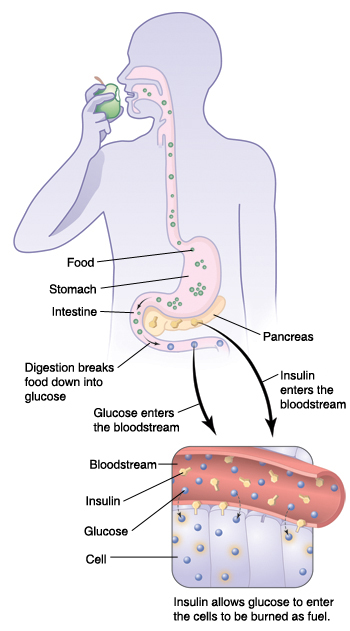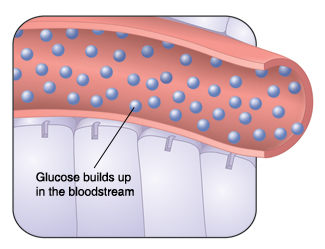Understanding Type 1 Diabetes
Understanding Type 1 Diabetes
To get energy, the body breaks down food into fuel. When you have diabetes, your body has trouble using this fuel for energy.
How the body normally gets energy
The digestive system breaks down food, resulting in a sugar called glucose. Some of this glucose is stored in the liver. But most of it enters the bloodstream and travels to the cells to be used as fuel. Glucose needs a hormone called insulin to enter the cells. Insulin is made in the pancreas, an organ in the abdomen. The insulin is released into the bloodstream in response to the presence of glucose in the blood. Think of insulin as a key. When insulin reaches a cell, it attaches to the cell wall. This signals the cell to create an opening that allows glucose to enter the cell.
When you have type 1 diabetes
Special cells (beta cells) within the pancreas actually make insulin. In most people, type 1 diabetes is an autoimmune disease. This means the body's immune system damages the beta cells. This decreases the amount of insulin made by the pancreas. In children, this usually happens quickly. In adult's, it isn't as fast. Without insulin, your cells can't get glucose to burn for energy. This is why you may feel weak or tired.
Glucose builds up
Without insulin, glucose can’t enter the cells. It stays in your blood instead. This may lead to higher and higher blood sugar levels (hyperglycemia). Over time, high blood sugar levels can cause serious health problems.
Ketones form
When your cells can’t get glucose to burn for energy, they burn fat instead. This leaves behind acids called ketones in your blood and urine (ketosis). High blood sugar, high ketones, and other chemical changes in the blood (metabolic acidosis can cause a dangerous condition called diabetic ketoacidosis (DKA). For some people, DKA is the first sign of type 1 diabetes.
Insulin can be replaced
The insulin you’re missing can be replaced with shots of insulin (injections). Some people also use insulin pumps. Then your body can burn glucose for energy. This helps keep your blood sugar within a healthy range.
Long-term complications
Over time, high blood sugar levels can damage blood vessels. This can lead to health problems (complications). Keeping your blood sugar in a healthy range can help prevent or delay complications. Balancing insulin, diet, and activity can help keep blood sugar levels in your target range and prevent complications. As do regular check-ups, lab tests, and exams. Complications that may happen include:
Eye problems
Kidney disease
Nerve damage
Digestion problems
Sexual dysfunction
Tooth and gum problems
Skin and foot problems
Heart and blood vessel disease
Updated:
October 13, 2017
Sources:
Diabetic autonomic neuropathy of the gastrointestinal tract. UpToDate
Reviewed By:
Hurd, Robert, MD,Image reviewed by StayWell medical illustration team.,Sather, Rita, RN

